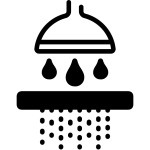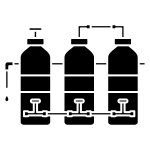A loose faucet handle is more than just a minor annoyance — it can lead to water leaks, reduced control, and eventual damage to your sink or countertop. Whether you’re dealing with a bathroom or kitchen faucet, knowing how to tighten a sink faucet handle is a simple DIY skill that every homeowner should master.
In this detailed guide, we’ll walk you through the entire process of tightening a sink faucet handle, the tools you’ll need, common faucet types, and even tips on when to consider replacing your faucet altogether. By the end, you’ll feel confident handling this small but crucial plumbing task — and know when it’s time to upgrade to premium hardware from Cuoll.
🚰 Why Does a Sink Faucet Handle Get Loose?
Before diving into the fix, let’s explore why sink faucet handles become loose in the first place:
- Frequent use: Daily turning and twisting wear out internal screws and connectors.
- Water corrosion: Moisture buildup can lead to rust, weakening the faucet’s internal grip.
- Improper installation: Handles not properly secured during setup can loosen over time.
- Worn-out components: Screws, nuts, or washers may degrade, especially in older faucets.
Understanding these causes can help you prevent recurring issues and extend the lifespan of your plumbing fixtures.
🧰 Tools You’ll Need to Tighten a Sink Faucet Handle
Before starting the tightening process, gather these basic tools:
- Allen wrench (usually 1/8-inch or 3/32-inch)
- Phillips or flathead screwdriver
- Adjustable wrench (for cartridge-style faucets)
- Flashlight or headlamp (for dark spaces under the sink)
- Cloth or towel (to prevent scratches)
- Faucet lubricant or plumber’s grease (optional)
- Bucket or tray (for water drips)
💡 Pro Tip: At Cuoll, we offer tool kits and faucet repair accessories designed for both beginners and professionals. Browse our Plumbing Tools Collection for affordable, durable options.
🔍 Identify Your Faucet Type
Not all faucets are created equal. Different models have different mechanisms, which slightly alters how you should tighten them. Here’s a quick breakdown:
| Faucet Type | Handle Style | Tightening Method |
|---|---|---|
| Compression Faucet | Two handles (hot/cold) | Tighten stem screw under cap |
| Ball Faucet | Single handle | Tighten Allen screw |
| Cartridge Faucet | One or two handles | Tighten mounting nut |
| Ceramic Disc Faucet | One handle | Tighten set screw at base |
If you’re unsure which type of faucet you have, check the user manual or search the brand/model number online.
🛠️ Step-by-Step: How to Tighten a Sink Faucet Handle
Here’s a step-by-step process that works for most sink faucet types:
Step 1: Turn Off the Water Supply
Safety first! Shut off both the hot and cold water supply valves under the sink. Turn the faucet on to release any remaining pressure.
Step 2: Plug the Drain
Use a sink plug or towel to block the drain — you don’t want small screws disappearing down the pipe.
Step 3: Examine the Faucet Handle
Look for a visible set screw or decorative cap:
- Set screw visible? Use an Allen wrench to tighten it.
- Cap present? Pry it off gently with a flathead screwdriver to access the screw underneath.
Step 4: Tighten the Handle
- Use the appropriate screwdriver or Allen key to turn the screw clockwise.
- If the screw is stripped or rusted, replace it with a matching one.
Step 5: Test the Handle
Turn the water supply back on and test the faucet. The handle should feel snug, with no wobble or delay.
Step 6: Clean Up
Wipe the area clean with a cloth and ensure all tools are removed from the workspace.
🔄 What to Do If the Faucet Handle Still Feels Loose
Sometimes, tightening the screw doesn’t solve the problem. Here’s what you can try:
- Replace internal components like the O-ring, washer, or cartridge.
- Apply plumber’s grease to reduce internal friction.
- Replace the faucet if it’s outdated or too corroded.
🛒 Upgrade Time? Cuoll offers premium water faucets and accessories that enhance functionality and design. Check out our Faucet Collection featuring modern, rust-resistant options.
🧼 Preventing Faucet Handle Issues: Maintenance Tips
To keep your faucet handle from becoming loose again:
- Tighten annually: Add handle tightening to your yearly maintenance checklist.
- Clean regularly: Avoid buildup of grime and mineral deposits around the base.
- Use gently: Teach family members to avoid yanking or forcing the handle.
- Check water pressure: High pressure can loosen parts over time.
🔧 Expert Tip: Pairing your faucet with a Cuoll water purifier reduces mineral content in the water, helping to prevent corrosion and scaling.
🌊 Related Plumbing Fixes You Can Try
Tightening your sink faucet handle is just one step toward a better home plumbing experience. Here are other common DIY fixes:
- How to Replace a Faucet Cartridge
- Fixing a Leaky Bathroom Faucet
- Installing a Cuoll Bathtub Faucet with Filter
- Eliminating Water Odor with Activated Carbon Filters
- Solving Water Pressure Issues at the Sink
Explore our blog for these full guides!
💧 How Cuoll Products Can Help Improve Your Plumbing
While you’re fixing your faucet, why not upgrade other areas of your water system? At Cuoll, we offer:
🔹 Water Filters & Purifiers
Remove chlorine, heavy metals, and bacteria for cleaner, healthier water. Pair your kitchen faucet with a Cuoll countertop filter or under-sink water purifier for maximum purity.
🔹 Bathtubs & Faucets
Upgrade your bathroom aesthetics with our modern, space-saving bathtubs and multi-function shower faucets.
🔹 Plumbing Accessories
We stock replacement cartridges, valves, hoses, and faucet parts compatible with popular brands.
🎁 When to Replace (and Not Just Tighten) Your Faucet Handle
Signs you may need a full faucet replacement:
- Repeated loosening despite tightening
- Corroded screws or mounting nut
- Water leaks even after handle repair
- Aesthetic damage or outdated style
If your faucet is over 10 years old, replacing it might be more cost-effective than constant repairs.
🛒 Cuoll Recommendation: Choose from brushed nickel, stainless steel, or matte black faucet designs that match your modern or traditional interior.
📦 Shop Sink Faucets and Plumbing Solutions at Cuoll
Here at Cuoll, we believe in providing top-quality, affordable solutions for your home improvement needs. Whether you’re a DIY homeowner or professional contractor, you’ll find everything you need in one place:
- ✅ High-Pressure Kitchen Faucets
- ✅ Bathroom Sink Faucets
- ✅ Wall-Mounted Water Purifiers
- ✅ Filtered Shower Heads
- ✅ Eco-Friendly Bathtubs
- ✅ Complete Faucet Repair Kits
🔗 Visit Our Store Now to browse, compare, and order!
🔚 Conclusion: Take Control of Your Faucet Troubles Today
Now that you know how to tighten a sink faucet handle, you’re ready to tackle one of the most common household issues with ease. A few minutes of maintenance can prevent water damage, save you money, and make your bathroom or kitchen feel brand new.
And when it’s time for a complete upgrade, remember that Cuoll has your back with high-quality water solutions — from purifiers and filters to stylish new faucets and bathtubs.







